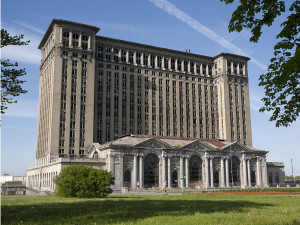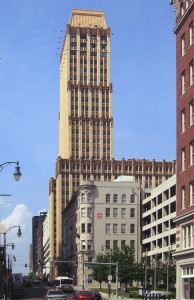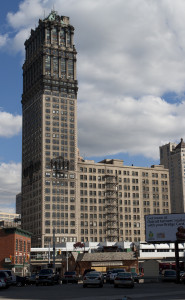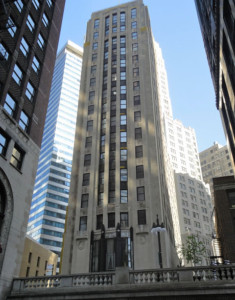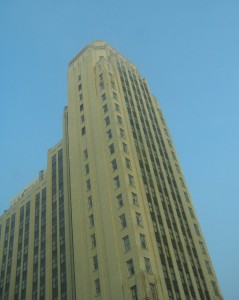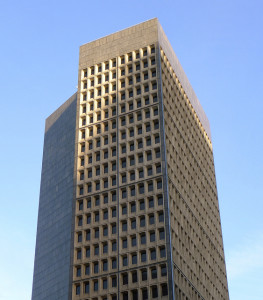Like ruins left behind by the great Romans or Mayans, America’s abandoned skyscrapers hide numerous stories behind their decaying facades. These high-rise gems, many of them Art Deco specimens, were the pride of their community when they were built. A developer’s vision, an architect’s dream, an engineer’s challenge, a workplace, a home, and now crumbling monuments to their enterprising creators. Oftentimes the towers are so beloved that a community can’t bare to see them go. And other times they just can’t afford to tear them down.
Michigan Central Station, Detroit
Once home to over two-million people, Detroit now has fewer than 800,000 and is filled with old, abandoned high-rises. Perhaps the greatest symbol of Detroit’s rise and fall is the old Michigan Central Station built in 1913 for Michigan Central Railroad. Located in the Corktown district of Detroit near the Ambassador Bridge, the 230-foot-tall building was once the tallest rail station in the world. It is of the Beaux-Arts Classical style of architecture, designed by the Warren & Wetmore and Reed and Stem firms who also designed New York City’s Grand Central Terminal. The price tag for this 500,000-square-foot building was originally $15 million.
The building is composed of the train station and an 18-story tower, but the top floors were never completely furnished or used. The main waiting room was modeled after an ancient Roman bathhouse with walls of marble and vaulted ceilings. The building also housed a large hall adorned with Doric columns that housed the ticket office and arcade shops. Beyond the arcade was the concourse, which had brick walls and a large copper skylight. From here, passengers would walk down a ramp to the departing train platforms, 11 tracks in all. Below the tracks and building is a large area for baggage and mail handling and offices.
Abandoned in the 1980’s, Michigan Central Station was scheduled for demolition in 2009 before a Detroit resident sued the city to save it, citing the National Historic Preservation Act. The future of the building remains uncertain though a group known as Michigan Central Station Preservation Society maintains a facebook page at https://www.facebook.com/MichiganCentral.
Sterick Building, Memphis
The Sterick Building is an office building in Memphis, Tennessee. It was designed by Wyatt C. Hedrick & Co., and was completed in 1930—its name is a contraction of the original owners’ names R.E. Sterling and Wyatt Hedrick. It is a gothic-style tower, 365 ft tall with 29 floors. When it opened it 1930 it was the tallest building in the South and was the tallest building in Tennessee until 1957. It is now the fifth-tallest building in Memphis. It stands at the corner of Madison Avenue and north 3rd Street.
Once called “the Queen of Memphis” the Sterick Building featured a white stone spire topped with a green tile roof; its own bank, pharmacy, barber shop and beauty parlor; and stockbrokers’ offices. The first three floors were made from granite and limestone. From the lobby, which was said to “rival the beauty of a Moorish castle,” its eight high-speed elevators carried the building’s 2,000+ workers and guests to the upper floors, including the Regency Room restaurant on the top floor.
The building began to decline in the 1960s, and, despite a number of alterations (including being repainted from its original white and green to yellow and tan), it has been left vacant since the 1980s. It was added to the National Register of Historic Places in 1978. Preservations are hoping the building will one day be converted to residential use, citing its location overlooking the Missippi River. The 350,883-square-foot property was appraised at $419,200 in 2005.
Book Tower, Detroit
Another of Detroit’s abandoned high-rises, Book Tower is a 476 ft, 38-story skyscraper in the Washington Boulevard Historic District. Construction began on the Italian Renaissance-style building in 1916 as an addition to the original Book Building and finished a decade later. Designed in the Academic Classicism style, the top several floors have very ornate facades and a green copper roof. Retail and gallery floors used to reside on the first and second floors, with businesses previously occupying the rest
From its opening through the mid-1970s the Book Tower remained a prestigious address on Washington Boulevard. Like many structures in the city, its fortunes declined until 1988 when the owners defaulted on the mortgage. In 1989, Travelers Insurance, the principal mortgage-holder, took possession and sold the building to developer John Lambrecht who previously purchased and renovated the Cadillac Tower a few blocks east. Lambrecht had similar plans for the Book Building and Tower, however his untimely death later that year brought things to a halt.
In 2009, the Detroit City Council’s Green Task Force announced that Key Investment Group had signed a contract with the Book’s owners to convert it into eco-friendly residences and retail space. However, no work was ever started.
The Chicago Motor Club Building, Chicago
The Chicago Motor Club Building, also known as Wacker Tower, is an exceptional example of an Art Deco-style skyscraper that also exemplifies the importance of the automobile to the history of early 20th-century Chicago. Built in 1928, the building was the long-time headquarters of the Chicago Motor Club, founded in 1906 to promote automobile ownership and to advocate on behalf of motorists.
The 15-story tower, designed by Holabird & Root, is located at 68 East Wacker, near the Trump Tower, Willis Tower and other major landmarks. The base is visually dominated by a highly-decorative and dramatic cast-iron surround that frames the building’s monumental entrance, with its three doorways and a set of triple-height windows above.
Developer Sam Roti purchased the tower in 1996 with the intention of converting it into condominiums. The plan would have involved converting each floor into a 4,400 square foot apartment unit with the top floor becoming a duplex penthouse. The rennovations never happend and the building has sat empty ever since.
Central National Bank, Richmond, Virginia
The Central National Bank building is an Art Deco skyscraper located in Richmond, Virginia. Completed in 1929, it was one of the first skyscrapers in the city of Richmond not in the heart of the financial district. According to architectural historian Richard Guy Wilson, it and the West Hospital building, are the only two skyscrapers in Richmond to have used the fashionable Art Deco ziggurat-inspired setback, and is among a handful in Virginia. When the bank later changed hands, it was known as the Central Fidelity Bank. The massive vaulted Art Deco banking lobby remains in excellent condition.
In 2005 developer Douglas Jemal purchased the building for $5.2 million with the intention of refurbishing the office and retail space but later relisted the tower for sale. He was unable to find a buyer. The building is listed on the National Register of Historic Places and located in the Broad Street Historic District.
The Ameritrust Tower, Cleveland
The Ameritrust Tower (formerly known as the Cleveland Trust Tower) is a high-rise building in the brutalist style located in downtown Cleveland, Ohio, United States. The building is 29 stories and rises to a height of 383 ft. It was designed by Marcel Breuer and Hamilton Smith and completed in 1971. The tower initially served as headquarters for Ameritrust Bank before its merger with Society Bank. Society Bank has since merged with Key Bank.
In 2007, the Cuyahoga County Commissioners voted to demolish the tower and to replace it with a new building. The Cleveland Planning Commission approved demolition but preservationists argued that the county would destroy a valued piece of architecture.
In December of 2012 it was announced that the County would sell the Ameritrust complex, including the tower, the rotunda building, and two other office buildings to the Geis Companies of Streetsboro, Ohio in exchange for $27 million.
Geis agreed to raze two other office buildings on the site and build a new eight story office building to be used by the county as a headquarters. The county plans to move about 750 employees into the newly constructed building and make lease payments of $6.7 million per year with an option to buy the new building after 26 years for $1.
Texas Tower, Houston
Oilman-banker-newspaperman, Ross Sterling, hired his son-in-law, architect Wyatt Hedrick (Hedrick & Gottlieb), to design the last of Houston’s 1920s-style skyscrapers, the Sterling Building, now known as Texas Tower, at 608 Fannin St. It was completed in 1931.
The building’s Art Deco pinnacles and stone facing were removed in the 1940s and today nothing remains of the original store fronts either, leaving little for preservationists to save.
Recent local news reports claim that Hines Properites may be preparing to demolish the tower to make way for a new 41-story, 815,000-sq.-ft. office building just as soon as an anchor tenant is found.
The Threefoot Building, Meridian, Mississippi
The Threefoot Building, built in 1929, is located in downtown Meridian, Mississippi. It’s the tallest building in the city, standing 16 stories tall and was added to the National Register of Historic Places in 1979. The Art Deco brick tower is named after the Threefoot family, Jewish-German immigrants who changed their name from Dreyfuss (“three foot” in German) to better reflect their new American home.
Just before the beginning of the Great Depression, the company founded by Abraham and carried on by his sons, built the Threefoot Building in downtown Meridian on 22nd Avenue adjacent to the Marks-Rothenberg Department Store and the Grand Opera House. A combination of shaky finances and the onset of the Great Depression caused the family’s business to cease operation, but the building continued under different ownership as an office building for several decades.
After Meridian’s first mall was built in the 1970s, the city began to focus less on economic development downtown, so the building’s tenants began to evacuate. By the 1990s, the building had been mostly abandoned. A recent fire on the 12th floor of the Threefoot building is still under investigation, according to Meridian Mayor Cheri Barry. The fire has prompted discussion again about what should be done with the building.
Sources include Wikipedia



